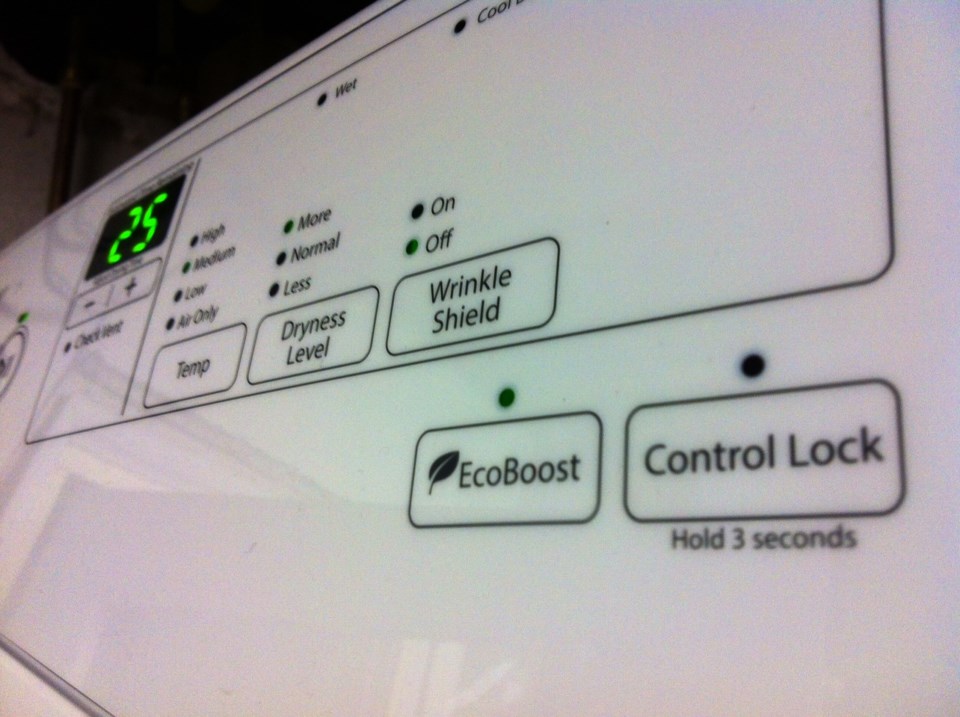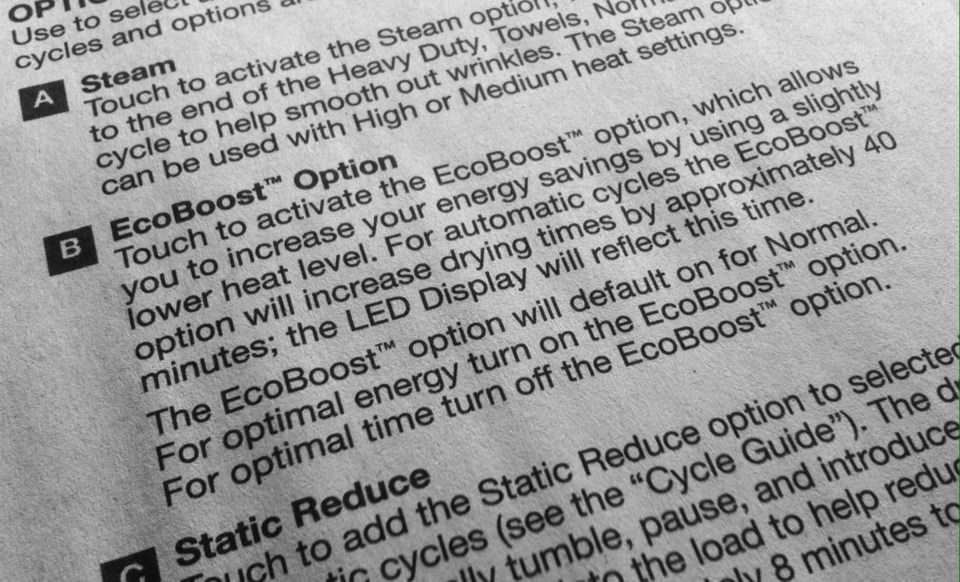
They are the energy hogs of our households. Clothes dryers, especially electric ones, suck up gobs of energy to blow hot air at wet clothes. They have essentially been the same for decades, unable to qualify for the Energy Star designations that other household appliances have won for slimming down their energy appetites.
Twenty years ago, electric dryer power-use stickers said they gobbled 900-plus kWh of electricity annually. Most stickers say the same thing today. (The faded one on our dryer from 17 years ago says 926 kWh).
A certain amount of energy produces a certain amount of heat. That reality has constrained dryer design.
But change is beginning to blow in, and a sprinkling of dryers have won Energy Star status.
Breakthroughs are starting to arrive, spurred in part by a U.S. Environmental Protection Agency contest.
There’s been no miracle in squeezing more heat out of electricity. Instead, the advances are coming with better sensors, software, and recirculated heat.
Moisture sensors that are more accurate gauge when a load of clothes is dry enough and shut off the heat. Over-drying is one of the inefficiencies of old-style dryers.
Another approach is to run dryers at lower heat, but longer, which uses less electricity. There are steam cycles to get rid of wrinkles and reduce the need for ironing. And cycles tailored for specific types of fabric.
An example of the new thinking is the Samsung DV457 dryer, which is controlled by a computerized touch screen and can link to a smartphone for remote control. The DV457 won the EPA’s Emerging Technology Award.
But all that fanciness costs money. The DV457 sells undiscounted for around $1,500 US. That’s just for the dryer. Its companion washer is around the same price. Cnet.com did a review, with video.
Less glitzy machines incorporating energy-saving features have arrived in stores, and ones that are even more efficient are on the horizon, spurred by new U.S. standards that come into effect in January 2015. Some of those models will qualify for Energy Star designation by using around 20 per cent less energy “than conventional models without sacrificing features or performance,” says an article on the Energy Star website.
Also coming to the North American market are condenser and heat pump dryers, which have been more common in Europe, where higher electricity costs have made them attractive. Instead of blowing hot moist air outdoors, they extract moisture and recycle the hot air. This means they need a tank to hold the extracted water, or a way to pump the water into a drain, typically the same one used by the washer.
Condenser and heat pump dryers — also marketed as ventless dryers — do not require a hole in an exterior wall for venting. Not having that hole helps to make a house more energy efficient. Ventless dryers can also be useful in apartments where putting a hole through an outside wall is impractical.
People have complained that some condenser dryers send heat into the room, making it uncomfortably hot. That seems to be less of an issue with heat pump dryers, which are more expensive but have a more advanced mechanism for extracting moisture and recirculating heat.
Prices for the new-age dryers are almost certain to be higher than for conventional ones.
If you’re in the market for a dryer next year, it might be worthwhile to do the math on whether the higher cost of an energy efficient unit will be balanced by electricity savings.
- - -
Of course, drying on a rack or on a line is a time-honoured alternative to the brute-force of a dryer. I spotted this gadget online. And this array of drying racks.
The energystar.gov has this list of Energy Star certified clothes dryers. The list in mid-October had models with estimated annual energy use of between 556 and 685 kWh, versus 900-plus for conventional dryers sold in the last couple of decades. Based on those numbers, using an Energy Star model would save around $20 a year in power costs if you're a B.C. Hydro residential customer.
B.C. Hydro is offering rebates for Energy Star dryers bought between Oct. 1 and 31.
Basic name-brand old-style dryers are selling for $500 to $800. [I have since wandered around more appliance stores and have spotted run-of-the-mill dryers selling for as low as $330. Fancier ones with more controls and better sensors, but not necessarily Energy Star rated, are $1,400 to $1,600; they also come in many colours that are not white, have curves, and may have pedestals.]
The Canadian Home Depot website lists a “compact” condensing dryer for $1,248.
Whirlpool Corp. issued a news release in July saying it would start selling dryers with heat pump technology in Canada in 2015.
Whirlpool announced its first Energy Star dryer in June.
laundry.reviewed.com has a story about heat pump dryers
The Energy Star website discusses clothes dryer efficiency and the new standard.
B.C. Hydro posted this article: Super-efficient clothes dryers: two reasons builders will love them. It also offers these tips for using a dryer: Shrink your dryer's energy use.

- - -
- - -
Most-popular posts:
Review: B.C. Hydro’s EMU-2, energy monitor and nag
Figuring out how to eat unfamiliar foods properly, like dosa
Despite hassles, travellers pack public transit for ferry trips
To stay cool, leave house windows closed or open?
A guide to public toilets in downtown Victoria
How to block unwanted text messages
Why B.C. Hydro bills sting more on Vancouver Island
Why newer dishwashers run for an alarmingly long time
Riding the ferry for fun, and for the buffet
Most credit cards charge 2.5% for currency conversion; a few charge 0%
Why paying $720 for a phone can be a better deal than a 2-year contract
Tips to make applying for a passport a little easier
How to pronounce Ucluelet, Tsawwassen, and that outdoor gear place
How to travel between Victoria and Vancouver on public transit
- - -


